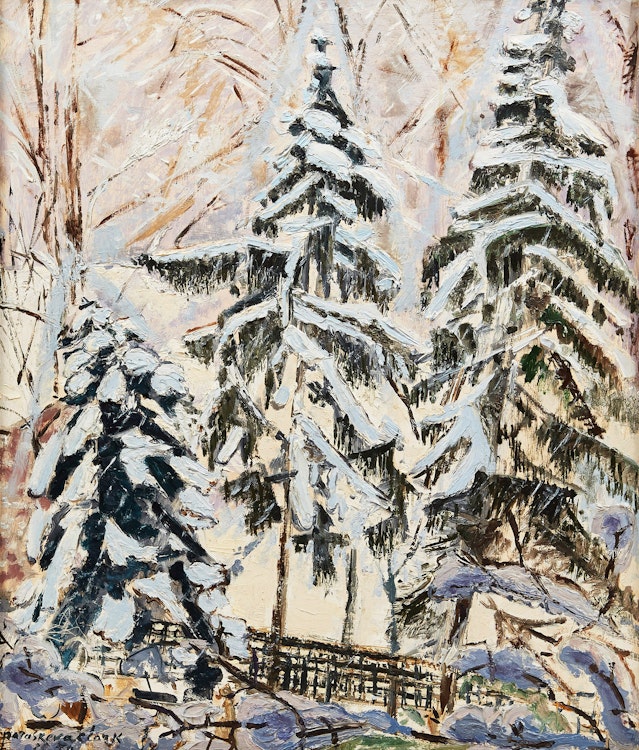Forest in Winter by Paraskeva Plistik Clark

Paraskeva Clark
Forest in Winter
oil on board
signed and dated 1959 lower left
24 x 20 ins ( 61 x 50.8 cms )
Auction Estimate: $1,500.00 - $2,000.00
Price Realized $2,040.00
Sale date: June 1st 2021
Private Collection, Ontario
Share this item with your friends
Paraskeva Plistik Clark
(1898 - 1986) Canadian Group of Painters, OSA, RCA
Born in Leningrad, Russia, she became very interested in art as a child and in her youth copied magazine illustrations, lithographs, and other reproductions. When she was 19 she worked long hours in an office and then took evening classes under Savely Zaidenberg. Following the Russian Revolution in 1918 she attended the “Free Studios” formerly known as the Imperial Academy of Fine Arts, where she studied under Vassily Schoukaeff and Petrov-Vodkin (1918-1921). She also followed her own plan of self teaching.
She lived in Paris from 1923 to 1931 and arrived in Toronto with her husband, a Canadian, in 1931. Graham McInnes wrote only five years later in the Canadian Forum “Her work has a combination of two qualities unusual in a painter – extreme sensitiveness and wiry strength. She has reacted quickly to her new environment, and has already made valuable contributions to Canadian landscape art.” In Canadian Art, 1949-50, Andrew Bell noted, “She could not, as a wife and mother move much about the country, but she could work up pictures of the intimate world close at hand . . . The portraits, and they are admirable, have been of her husband, her sons, close friends, or if none of these were about – then in seeming desperation, of herself.” Donald W. Buchanan in his book “Growth of Canadian Painting” placed her among the notable Canadian artists. Perhaps the most definitive article thus far was a transcript of an interview between Lawrence Sabbath and the artist in Canadian Art, No. 70. Here she indicated her preference for working directly on canvas, when she had the time, but as a second choice did small sketches from which she “painted up” larger works. From the one sketch, she did several, each becoming more and more abstract.
Paul Cézanne perhaps influenced her more than any other artist and this can be clearly seen in her work. She moved towards a freer style but never abandoned her genuine portrayal of the world about her. In 1944 she was appointed by the National Gallery of Canada to paint activities of the Women’s Divisions of the Armed Services. She also did silk screen prints as part of a project to provide the armed services hostels with scenes of their own country. She gave lectures on Soviet Art at the Art Gallery of Toronto and the Heliconian Club.
Her work has been exhibited at the Picture Loan Society and the Laing Galleries, Toronto and in many group shows. She was a member of the Canadian Group of Painters (1936); Canadian Society of Painters in Water Colour (1937); Canadian Society of Graphic Art (1938) (resigned 1940); Ontario Society of Artists (1954); Royal Canadian Academy (ARCA 1956). Some of her better known work are: “The Pink Cloud” (NGC), Self Portrait (NGC) and “Tom Thomson Cairn and Totem”. She is represented in the Napier Gallery in New Zealand; Hart House, University of Toronto; and the National Gallery of Canada by a number of works. She lived in Toronto.
Source: "A Dictionary of Canadian Artists, Volume I: A-F", compiled by Colin S. MacDonald, Canadian Paperbacks Publishing Ltd, Ottawa, 1977

